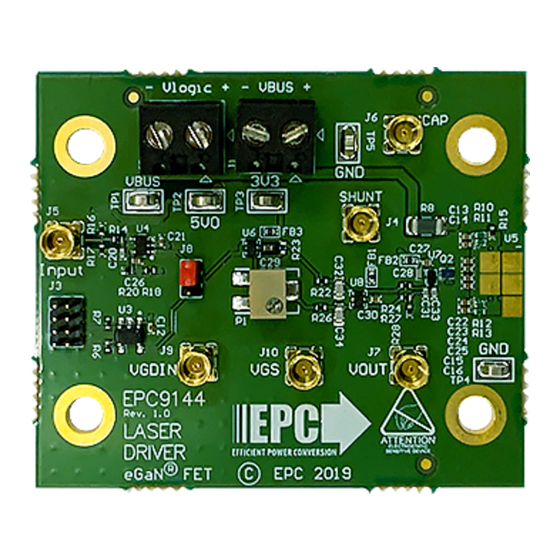- ページ 4
マザーボード EPC EPC9144のPDF クイック・スタート・マニュアルをオンラインで閲覧またはダウンロードできます。EPC EPC9144 9 ページ。 Development board for a 15 v high current pulsed laser diode driver

QUICK START GUIDE
Figure 5 shows an example of an Excelitas SMD laser diode mounted
with one of the interposers.
Finally, a ground pad is made available for those who wish to use the
board for alternative applications.
The recommended procedure for the use of the interposer is the following:
1. Apply solder paste to the U2 pads on the EPC9144 PCB.
2. Apply solder paste to the appropriate pads on the top side of the
interposer.
3. Carefully place the desired interposer with the bottom side facing the
top side of the EPC9144 on the U2 footprint.
4. Place the laser diode or desired load on the interposer.
5. Reflow the entire assembly with the recommended temperature
profile for the solder used. The use of a reflow oven that can meet the
recommended soldering specifications is highly recommended. Other
reflow methods may also be used based on the experience of the user.
The power loop inductance, including that of the laser diode, is a primary
factor that determines the shape of the laser pulse. Considerable effort
has been made to minimize power loop inductance while maximizing
the choice of laser diode and its orientation. The discharge caps, laser
diode or other load, and the eGaN FET must all be mounted in close
proximity to minimize inductance. As a result, the user must take care not
to damage any components when mounting the laser or changing other
components in the power loop.
The EPC9144 is capable of driving laser diodes with current pulses
can result in peak powers of several tens of watts of optical power.
Laser diodes for lidar applications may be designed with this in mind, but
thermal limitations of the laser package mean that pulse widths, duty
cycles, and pulse repetition frequency limitations must be observed.
Read laser diode data sheets carefully and follow any manufacturers'
recommendations.
MEASUREMENT CONSIDERATIONS
MMCX jacks are provided to measure several voltages in the circuit,
including gate drive input, Q1 gate voltage, Q1 drain voltage, charge
voltage of the energy storage cap. All measurement points are designed
to be terminated in 50 Ω, hence when viewing waveforms, the
oscilloscope inputs should be set to a 50 Ω input. Ideally, unused inputs
should be also terminated with a 50 Ω load to prevent the probes from
creating additional resonances. The Q1 drain voltage and the discharge
cap sense voltage have on-board terminations to greatly reduce this
effect, and in practice, the remaining resonances are small enough to
ignore in most applications. It is recommended that the user verify this
for their own requirements.
All sense measurement MMCXs, except for the shunt measurement,
use the transmission line probe principle to obtain waveform fidelity at
sub-ns time scales. They have been verified to produce near-identical
EPC – THE LEADER IN GaN TECHNOLOGY |
WWW.EPC-CO.COM
| COPYRIGHT 2019 |
SMD lasers
MMCX
Left
Bottom
Figure 4: EPC9989 interposer. Note that this board is revised as needed to accommodate
new lasers and other loads as needed, so the picture may not show the latest revision.
eGaN FET
Current
shunt
Discharge
capacitors
EPC9126
Laser diode
or load
Figure 5: Laser diode mounting on output terminals with interposer
results to a Tektronix P9158 3 GHz transmission line probe. As a result
of their design, they have a built-in attenuation factor. The impedance
of the probes at the measurement node is relatively small (~1kΩ).
The user should keep this in mind if accustomed to more conventional
oscilloscope probes.
The current shunt J4 is not used at this time. A future revision may
include this functionality.
Table 2 summarizes the properties of the MMCX test points for ease
of reference.
Demonstration System EPC9144
Alternate loads
Gate driver
EPC9989
interposer
Breakaway
V-grooves
Recharging
resistors
| 4
